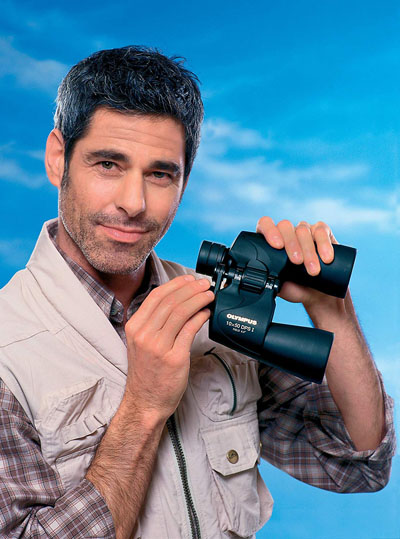Outdoor enthusiasts benefit a lot from a reliable pair of binoculars. Whether it’s a sports event, birdwatching, observing nature or something else entirely, the binoculars are there to deliver the images you need.
One such company that truly cares about visuals is Olympus. And among its star models is no other than the Olympus Trooper 10×50 DPS I binocular. Let’s see why people rave about it. Having said that, we’ll touch on its key specifications, pluses, minuses, as well as questions that often confuse some customers.

Olympus Trooper 10×50 DPS I Binocular Review

The model’s rugged and rubberized coating makes it durable in harsh conditions. Connected to that, the user can have a much firmer grip thanks to it.
When it comes to delivering images, the lenses let through bright and crisp visuals. And that stands for different settings, even low-light conditions. That’s due to the porro prism and the Bak-7 system.
Also, there are no reflections or distortions for easier viewing. The binoculars can boast with a pretty large field of view that captures the desired subjects as well as the surroundings. This includes subjects that move swiftly as the model can catch these as well. The UV protection layer adds more safety, too.
The focal system is central. That means that the focus knob on the center is the one for adjustments.
- Magnification: 10x
- Field of view: 342 feet at 1000 yards
- Porro Prism, Bak-7 lens
- Exit pupil: 5 millimeters
- Weight: 1.88 pounds
- Lens diameter: 50 millimeters
- Dimensions: 7 x 7.5 x 2.5 inches
- Lens coating prevents reflections
- Protection against ultraviolet rays
- Quality visuals
- Center focus system
- Price
- Dioptric correction modifications
- A bit heavier
- Isn’t waterproof nor fog proof
Frequently Asked Question (FAQs)
1) What does DPS in the Binoculars name stand for?
Answer: When you take a look at other models which are called EXWP, WP I, PC III, and others, you wonder if it’s a coincidence. However, Olympus doesn’t put these names without a certain meaning. Moreover, the majority think that in the case of DPS, each letter equals a certain specification. ‘D’ is for the Bak-7 lens. ‘P’ for the prism type – Porro Prism. And ‘S’ means standard.
2) Do the Binoculars come with some accessories?
Answer: Like in the case of most models out there, the answer is affirmative. Buyers get a soft carrying case with a zipper as well as lens covers and a neck strap when they make the purchase.
3) Can i bring them on my safari trip?
Answer: These binos serve well for different purposes. And safari is definitely one of them.
Conclusion
Besides its minor drawbacks, overall, we’re talking about a decent model for general purposes. The price is very affordable for anyone’s pocket. Buyers get durability, brightness, details, and enough protection.
But it’s your turn now? Did this Olympus model catch your eye? Or do you already own one? Tell us your thoughts and experience!
More Essential Binoculars Guides:
- Whale Watching Binoculars
- Top-Rated American Developed Binoculars
- Best Binoculars For Maritime, Marine Binoculars less than $500
- High Quality Image Stabilized Binoculars for Marine Adventure
- High Quality Cheap Binoculars
- Best Hiking Binoculars under $100
- Best Hiking Binoculars under $200
- Best Binoculars For Wildlife View
- Best Birdwatching Binoculars under $400
- Best Bird Watching Binoculars under $500
- Best Binoculars For Hunting, less than $1000
- Best Lightweight Binoculars less than $100
- High Quality Hiking Binoculars less than $100
- Best Binoculars For Hunters, $150 Hunting Binoculars, $1000 Hunting Binoculars
- Best Small Size Binoculars under $100
- Vortex Diamondback Binoculars, Reviews & Guide
- Best American Made Small Binoculars
- Best Binoculars for Bird Watching, Reviews & Guide
- Best Size Binoculars for Bird Watching, Reviews & Guide
- Best Small Binoculars For Birding, Reviews & Guide
- Best Bird Watching Binoculars Under £100, Reviews & Guide
- Best Birding Binoculars Under $500, Reviews & Guide
- Best Bird Watching Binoculars under $200, Reviews & Guide
- Best Lightweight Binoculars For Bird Watching, Reviews & Guide
- Best Night Vision Binoculars for Wildlife, Reviews & Guide
- Best Binoculars For Astronomy, Reviews & Guide
- Best Night Vision Binoculars For Stargazing, Reviews & Guide
- Best Binoculars with Digital Camera, Reviews & Guide
- How to Choose the Best Binoculars for Bird Watching
- Best Night Vision Binoculars in the World, Reviews & Guide
- Best Inexpensive Night Vision Binoculars, Reviews & Guide
- A Widespread Binocular Guides, Reviews and Tips & Tricks

